
The world of commercial real estate offers a diverse range of investment opportunities, with office and industrial properties standing out as two prominent options. Each property type comes with its own set of characteristics, advantages, and challenges. In this article, we will explore the key differences between office and industrial properties, and provide valuable insights into the investment considerations associated with each.
Understanding Office PropertiesOffice properties serve as the headquarters, administrative centers, and working spaces for businesses across various industries. These properties can range from traditional office buildings to modern co-working spaces. Let's take a closer look at the characteristics and investment considerations for office properties:
1. Location and Accessibility
Office properties are often located in commercial districts, urban centers, and business hubs. Proximity to transportation, amenities, and a skilled workforce is crucial for attracting tenants. Location plays a vital role in determining the property's value and demand.
2. Tenant Profile
Office properties attract a diverse range of tenants, including professional services, technology firms, finance companies, and more. Lease terms can vary, with long-term leases being common for established businesses. The stability of tenants can contribute to a steady income stream.
3. Lease Structure
Lease structures for office properties typically include gross leases, net leases, and modified gross leases. The type of lease will determine the responsibilities of both the landlord and tenant for property expenses such as maintenance, taxes, and utilities.
4. Property Management
Maintaining office properties often involves regular upkeep, cleanliness, and creating a professional environment. Property management may include services such as security, cleaning, and maintenance to ensure a comfortable and productive workspace for tenants.
Understanding Industrial Properties
Industrial properties encompass warehouses, distribution centers, manufacturing facilities, and more. These properties facilitate the storage, production, and distribution of goods. Here are the key characteristics and investment considerations for industrial properties:
1. Location and Accessibility
Industrial properties are strategically located near transportation networks such as highways, railways, and ports. Proximity to suppliers and markets is essential for efficient logistics and supply chain operations.
2. Tenant Profile
Tenants of industrial properties often include manufacturers, distributors, e-commerce companies, and logistics firms. Lease terms may vary, with short-term leases being common in some segments to accommodate changing business needs.
3. Lease Structure
Lease structures for industrial properties can include triple net leases, gross leases, and modified gross leases. In triple net leases, tenants are responsible for property expenses in addition to rent, making these leases potentially more passive for landlords.
4. Property Features
Industrial properties require specific features tailored to tenant requirements. These features may include high ceilings, loading docks, ample storage space, and efficient floor layouts to support logistics and production operations.
Investment Considerations
When deciding between office and industrial properties, several factors come into play:
1. Market Demand and Trends
Evaluate the local market demand for both property types. Consider factors such as job growth, population trends, and the presence of key industries to determine the property type that aligns with the market's trajectory.
2. Risk and Return
Office properties may offer stable, long-term leases, while industrial properties might have shorter leases but potentially higher demand due to the rise of e-commerce. Assess your risk tolerance and investment goals to choose the property type that matches your expectations for returns and stability.
3. Location and Accessibility
The importance of location cannot be overstated. A well-located property in proximity to essential amenities, transportation networks, and target tenant demographics can enhance your property's attractiveness and potential for appreciation.
4. Tenant Relationships
Consider your willingness and ability to manage tenant relationships. Office properties may require more communication and responsiveness to tenant needs, while industrial properties might offer more passive income potential.
5. Economic Resilience
Both property types have demonstrated their resilience in different economic cycles. Office properties may be influenced by office-space trends and remote work dynamics, while industrial properties are driven by logistics and manufacturing demands.
Investing in commercial real estate offers a world of opportunities, and choosing between office and industrial properties requires careful consideration of their distinct characteristics and investment implications. While office properties provide a hub for businesses and diverse tenant profiles, industrial properties facilitate the movement of goods and respond to the demands of modern commerce. By understanding these key differences and assessing factors such as market trends, location, lease structures, and tenant profiles, you can make an informed decision that aligns with your investment goals and risk tolerance. Whether it's the dynamic atmosphere of office spaces or the logistical backbone of industrial facilities, both property types have the potential to be rewarding investments in the ever-evolving commercial real estate landscape.
TAGS: Musings
